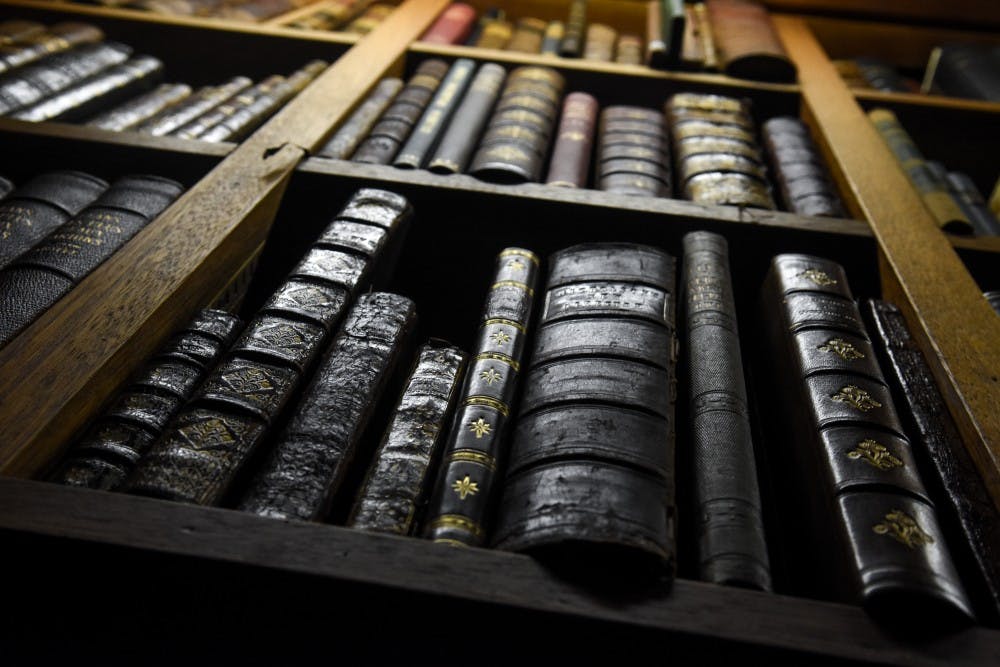Penn began offering an architecture program in 1868, but its collections of architectural publishings originated back in 1490s. Only if we take a peek at the Rare Books Library can we come in touch with several of these publishings. A little, ordinary room that sits steps away from the circulation desk in the Fisher Fine Arts Library, the Rare Books Library stores some of the oldest text materials at Penn, focusing on subjects from urban planning to Japanese contemporary photography.
Founded by Holmes Perkins, an architect, urban planner, and Dean of the School of Fine Arts at Penn from 1951–1971, the Rare Books Library was a haven for Perkins to house an ongoing collection of architectural designs and publications. As the university library began to expand its collection in the sixties, Perkins realized that Penn lacked many of the earlier monuments of architectural publishing he had found during his time teaching at Harvard.
In the beginning, Perkins envisioned the collection to reflect what he took to be architecture: a continuum. To understand the modernism of Le Corbusier, Gropius, and Mies van der Rohe needed context. Each of these architects were part of a larger and older narrative of the history of architecture. Perkins wanted students to take a long view and see how the current ideas could be traced. Thus, he began to devote considerable time and energy to the collection of select publishings in the history of architecture, which later culminated in the Rare Books Library. “What was important to Holmes Perkins through this collection was for the students to see the evolution of architectural thinking with primary materials,” said Hannah Bennett, Director of Fine Arts & Museum Libraries.
One of the foremost works in this collection are those from the Renaissance detailing Vitruvius. A Roman architect and engineer of the 1st century BCE, Vitruvius is known almost exclusively through his famous ten volume work On Architecture. At Penn, the collection holds several editions of his works as interpreted by five Renaissance figures: Alberti, Scamozzi, Serlio, Vignola, and Palladio. These books comment on architectural education and principles of architecture, and present the code of architectural practice in Rome at the time and the elements of the practice in general. While the name Vitruvius may sound obscure, it was the basis for many of the architectural monuments seen today, from Sofflot’s Pantheon in Paris to James Stuart’s Doric Portico in England to Jefferson’s designs for Monticello and the Virginia State Capitol.
In addition to books on architectural principles and practice, the collection also includes clusters of publications on subjects such as landscape architecture, bridge engineering, and the development of urban planning. Furttenbach’s Architectura martialis (1630), a select collection of works on city fortification, was developed by Perkins to support teaching in urban history. In his courses, Perkins referred back to the book to discuss and illustrate the importance of fortified cities and associated earthworks in influencing the form of a city.
Today, the Rare Books Library has extended its boundary beyond architectural publishings to new areas; it is not intended to be comprehensive but it does aim to gather key publications in subjects including prints, maps, design, and photography, for which the overall collections of the Fisher Fine Arts Library provide complementary material.
“Our oldest material was from late 15th century, and our most contemporary material was from like yesterday,” Bennett said. “Concurrent to Perkins’s works to the collection, we as librarians started buying materials that would suit not only his commitment to a more holistic art experience, but also our fine arts and art history curriculum. So today you see not just the core–the architecture and city planning–but also contemporary photography, artists’ books, and interactive maps.”
The collection is a wonderful study in history of not only architecture, but also publication, archaeology, and art materials. Meanings lie in the materiality and technicality of the books themselves besides their content. Housed in a room of modest size in the Fisher Fine Arts Library, the Perkins Rare Books Library stands as one of the university’s treasures, serving hundreds of thousands of users each year, from professors to students, and from visiting scholars to book artists. And it’s still growing.







